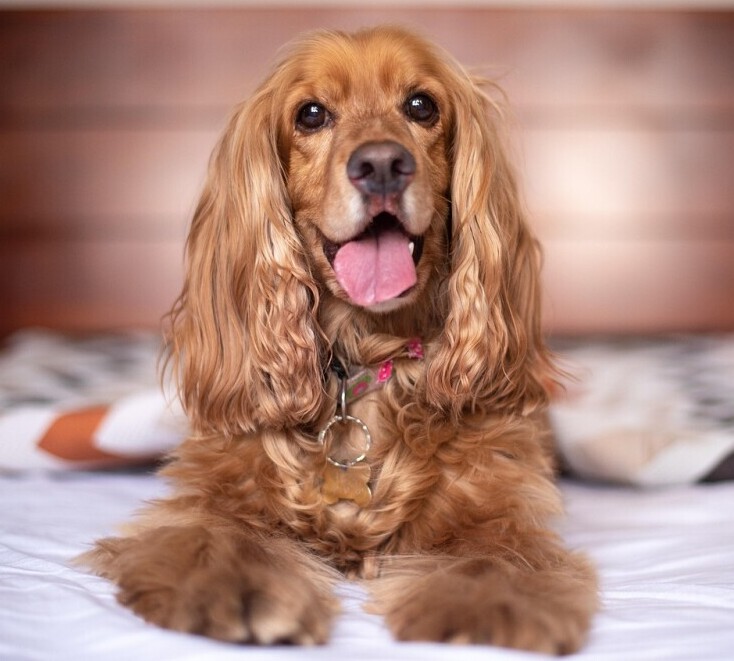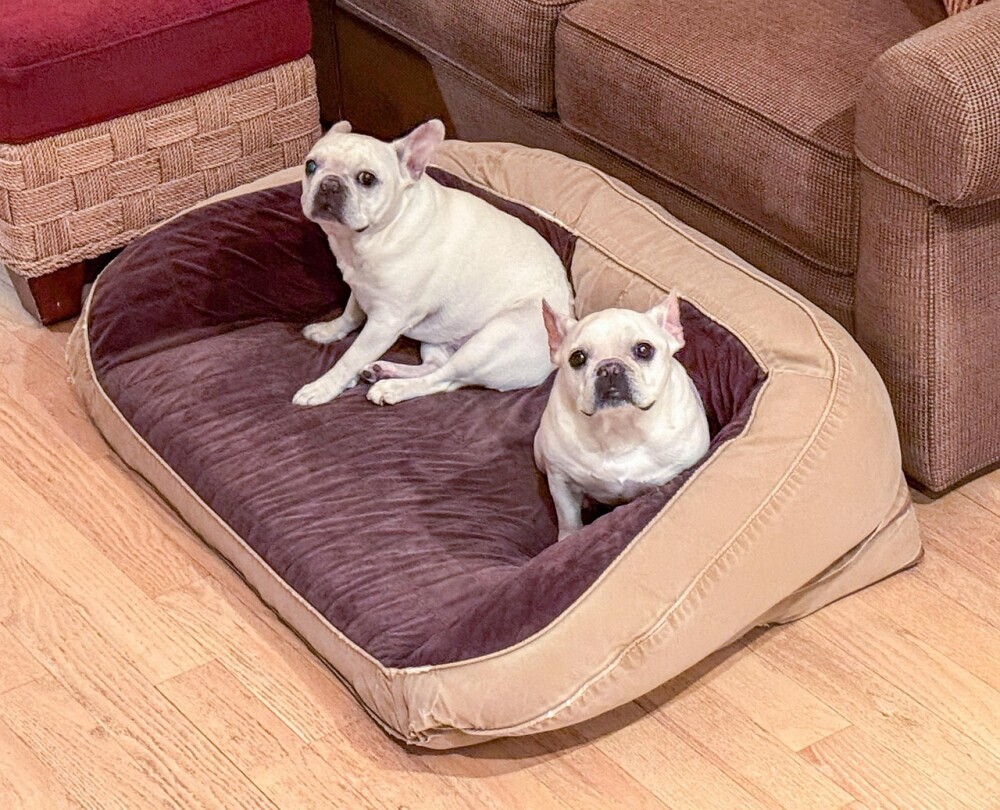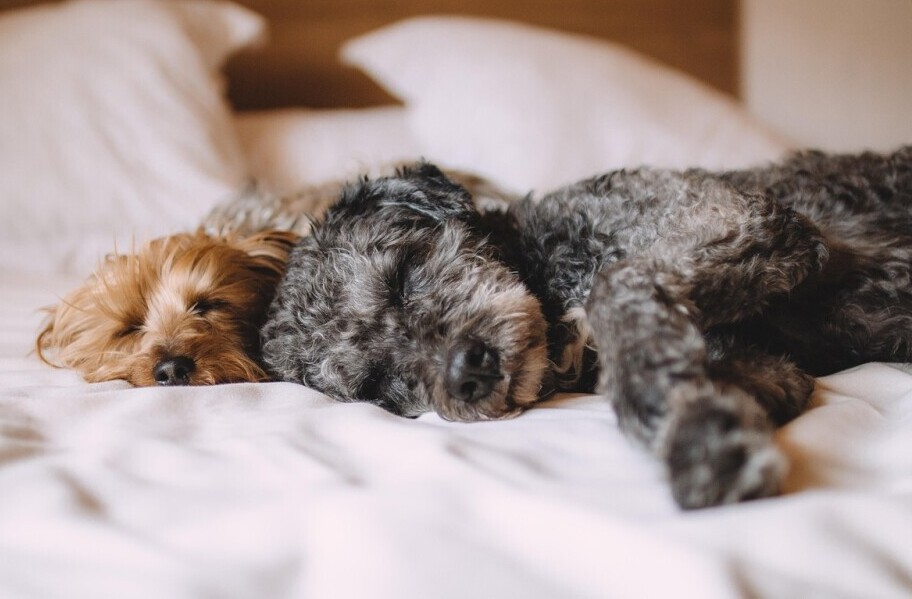
A few of the links in this post are affiliate links. If you buy something, we may earn a small commission (no extra bones from your wallet 🐾). Thanks for helping support the site and all of the dog adventures!
Dogs, much like us, have unique preferences when it comes to sleeping. Some might curl up into a tight ball, while others sprawled out on their backs, enjoying the freedom of space. These sleeping positions are more than cute; they tell us a lot about their sense of security and comfort. A bed is a safe space for a dog, so we want to help you get them to feel right at home in their own bed.
The denning instinct is a notable behavior in our canine companions. Just like wild dogs and wolves, domestic dogs still carry a natural desire to seek out the safety of a den-like environment to rest. This instinct guides them to look for cozy, enclosed spaces where they can feel secure and at ease. It’s a completely natural thing that your dog would want a safe place to rest.
There’s a common myth that says dogs prefer to sleep anywhere they drop, but this isn’t entirely true. Sure, they might doze off on the floor, but given the choice, many will choose a spot that feels both safe and snug. And you can help give them that cozy spot that they will always look forward to.
Sleep plays a vital role in a dog’s overall health. It affects everything from their mood to their energy levels. Without proper rest, they can become just as cranky and out-of-sorts as humans do, maybe even more so. Understanding these preferences is the first step to ensuring your dog gets the rest they need in their own bed.
Some dogs need extra help settling down at night. Support them with Best Calming Aids for Anxious Dogs.

Selecting the Right Bed for Your Furry Friend
Choosing the perfect bed for your dog can feel overwhelming with so many options out there, but focusing on a few key elements can help narrow things down. It’s not just about picking what’s trendy or what matches your living room decor, it’s all about what suits your dog best. Take into consideration your dog’s needs when thinking about their bed.
Dog beds come in various styles, such as orthopedic, nest-like, or even cot-style. Each offers different levels of support and comfort. Orthopedic beds are great for older dogs or those with joint issues, providing extra cushioning that takes the pressure off their bones. Nest-like beds offer a sense of enclosure, perfect for those dogs that love to burrow or feel hidden.
The size and material of the bed are also crucial factors. A bed that’s too small might not allow your dog to stretch out comfortably, while one too large might not offer that snug feeling some dogs crave. As for materials, look for something durable yet soft enough for comfort, and ideally, it should be washable since dogs have a knack for turning anything into a mess.
Age and health play a huge role in selecting a bed as well. Puppies might need something resistant to chewing, while an older dog might appreciate a softer surface. Keep these aspects in mind when shopping, and remember to think long-term a quality bed can last years if chosen with care.
Some insiders’ tips include observing where and how your dog currently likes to sleep. Understanding these preferences is beneficial when transitioning them to a new bed, so don’t hesitate to test out different types if you’re unsure. It may take a little trial and error to see what your dog really likes, but it will be worth it.
Rewarding proper bed habits helps reinforce them. See strategies in How to Use Treats for Dog Training.

Setting the Scene: Creating a Comfortable Sleeping Environment
Finding the right spot for your dog’s bed at home can make a big difference. Dogs are social animals, so placing their bed in an area where they can observe or be close to the family is usually a good call. But you’ll want to avoid high-traffic zones where noise might disrupt their peace. For example, we wouldn’t recommend putting their bed in a hallway with much traffic passing through. A nice and comfortable spot that’s out of the way of foot traffic will do best.
The environment around your dog’s bed is just as important as the bed itself. Consider the aspects of lighting, temperature, and noise. Dogs generally sleep better in dimly lit areas and rooms that are quiet. If your home tends to get noisy, a space away from hustle and bustle might be needed for nighttime rest. Keeping the area cool, but cozy, adds another layer of comfort.
Making the bed inviting is a cinch. Consider adding soft covers or an old piece of your clothing to give them a sense of comfort and security. Many dogs find that the familiar scent can be calming as they settle down for a snooze. So if you have any extra clothes that you don’t need anymore, maybe your pup will enjoy them!
Scents play a unique role in a dog’s sleeping pattern. Using mild, dog-safe fragrances like lavender can help create a calm environment for bedtime. Just ensure anything you use is safe for pets to avoid any unintended issues. The aim is to make their sleeping area as welcoming and relaxing as possible, supporting a restful night’s sleep.
Sleep habits develop early. Track your puppy’s progress in Your Puppy’s First Year: A Month by Month Guide.

Gradual Introduction and Training Techniques
Starting off on the right paw with training your dog to sleep in their own bed can take a bit of time, but patience makes all the difference. Whether you’re dealing with a puppy or a seasoned canine, introducing this new behavior gradually is key.
Begin by familiarizing your dog with the bed during the day. Place some of their favorite toys or a few treats on the bed to create positive associations. Encourage them to sit or lay on it by using happy, upbeat voice cues. It may take a minute for them to warm up to their new bed, so don’t worry if they don’t use it at first.
Positive reinforcement is your best friend here. Whenever your dog uses their bed, even for a brief stretch, reward them with praise or a little treat. This reinforces the idea that the bed is a desirable place to be. Let them know that it’s a good place for them to be so that they feel okay knowing they can stay there.
Some dogs may show reluctance or anxiety about a new bed. Address this by making the bed part of their playtime or safe space, ensuring they do not feel forced or rushed into using it. Don’t try to force them onto the bed, let them ease into it by making the bed comfortable and safe with a blanket and some toys.
Maintaining consistency in using verbal cues and reinforcement helps in instilling this new habit. It’s about making the whole experience as enjoyable and rewarding as possible so they naturally gravitate toward their bed. Remember, try not to get frustrated if your pup doesn’t catch on immediately. Success comes with time and a consistent, gentle approach.
Many dogs develop clinginess or night-time anxiety. Find solutions in Common Dog Behavior Problems and How to Fix Them.

Maintaining Good Sleep Habits for Your Dog
Keeping an eye on how your dog uses their bed can signal whether they’re truly comfortable. Curling up quickly and settling easily usually means they’re cozily accustomed to their sleeping setup. Let them get their scent on it so it can become familiar to them.
Bed aversion or restlessness might pop up now and then. If your dog suddenly seems uninterested in their bed, it could be a sign something’s amiss with their comfort or health. A quick check on the bed’s state or a chat with their vet might provide answers.
Creating a bedtime routine can help signal your pup that it’s time to wind down. This could be a calming walk, a quiet play session, or even a little cuddle session before softly guiding them to their bed. Having a nighttime routine will help your dog understand when it’s time to go to their bed.
Nighttime issues, like persistent barking or midnight pacing, can disturb both your rest and theirs. Address these problems by ensuring they’ve had enough exercise throughout the day or possibly re-setting their evening routine. Wear them out during the day so they won’t want to do anything at night but cozy up in their new bed.
Regularly review your dog’s sleeping area to ensure its ongoing comfort and safety. Making small adjustments based on your pup’s changing needs ensures they continue to enjoy restful nights in their own cozy spot. It may take a little while, but in time your dog will learn to love their new bed and it will become their new safe haven at home.
